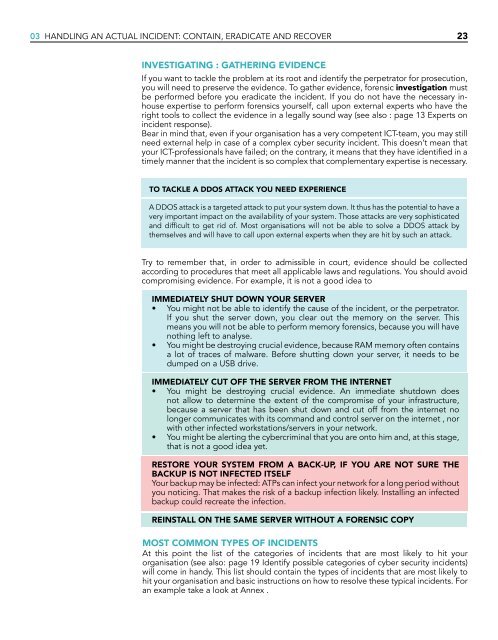CYBER SECURITY INCIDENT MANAGEMENT GUIDE
Cyber-Security-Incident-Management-Guide-2015
Cyber-Security-Incident-Management-Guide-2015
You also want an ePaper? Increase the reach of your titles
YUMPU automatically turns print PDFs into web optimized ePapers that Google loves.
03 HANDLING AN ACTUAL <strong>INCIDENT</strong>: CONTAIN, ERADICATE AND RECOVER 23<br />
INVESTIGATING : GATHERING EVIDENCE<br />
If you want to tackle the problem at its root and identify the perpetrator for prosecution,<br />
you will need to preserve the evidence. To gather evidence, forensic investigation must<br />
be performed before you eradicate the incident. If you do not have the necessary inhouse<br />
expertise to perform forensics yourself, call upon external experts who have the<br />
right tools to collect the evidence in a legally sound way (see also : page 13 Experts on<br />
incident response).<br />
Bear in mind that, even if your organisation has a very competent ICT-team, you may still<br />
need external help in case of a complex cyber security incident. This doesn’t mean that<br />
your ICT-professionals have failed; on the contrary, it means that they have identified in a<br />
timely manner that the incident is so complex that complementary expertise is necessary.<br />
TO TACKLE A DDOS ATTACK YOU NEED EXPERIENCE<br />
A DDOS attack is a targeted attack to put your system down. It thus has the potential to have a<br />
very important impact on the availability of your system. Those attacks are very sophisticated<br />
and difficult to get rid of. Most organisations will not be able to solve a DDOS attack by<br />
themselves and will have to call upon external experts when they are hit by such an attack.<br />
Try to remember that, in order to admissible in court, evidence should be collected<br />
according to procedures that meet all applicable laws and regulations. You should avoid<br />
compromising evidence. For example, it is not a good idea to<br />
IMMEDIATELY SHUT DOWN YOUR SERVER<br />
• You might not be able to identify the cause of the incident, or the perpetrator.<br />
If you shut the server down, you clear out the memory on the server. This<br />
means you will not be able to perform memory forensics, because you will have<br />
nothing left to analyse.<br />
• You might be destroying crucial evidence, because RAM memory often contains<br />
a lot of traces of malware. Before shutting down your server, it needs to be<br />
dumped on a USB drive.<br />
IMMEDIATELY CUT OFF THE SERVER FROM THE INTERNET<br />
• You might be destroying crucial evidence. An immediate shutdown does<br />
not allow to determine the extent of the compromise of your infrastructure,<br />
because a server that has been shut down and cut off from the internet no<br />
longer communicates with its command and control server on the internet , nor<br />
with other infected workstations/servers in your network.<br />
• You might be alerting the cybercriminal that you are onto him and, at this stage,<br />
that is not a good idea yet.<br />
RESTORE YOUR SYSTEM FROM A BACK-UP, IF YOU ARE NOT SURE THE<br />
BACKUP IS NOT INFECTED ITSELF<br />
Your backup may be infected: ATPs can infect your network for a long period without<br />
you noticing. That makes the risk of a backup infection likely. Installing an infected<br />
backup could recreate the infection.<br />
REINSTALL ON THE SAME SERVER WITHOUT A FORENSIC COPY<br />
MOST COMMON TYPES OF <strong>INCIDENT</strong>S<br />
At this point the list of the categories of incidents that are most likely to hit your<br />
organisation (see also: page 19 Identify possible categories of cyber security incidents)<br />
will come in handy. This list should contain the types of incidents that are most likely to<br />
hit your organisation and basic instructions on how to resolve these typical incidents. For<br />
an example take a look at Annex .


